AMD Reveals Radeon VII: High-End 7nm Vega Video Card Arrives February 7th for $699
by Ryan Smith on January 9, 2019 1:00 PM EST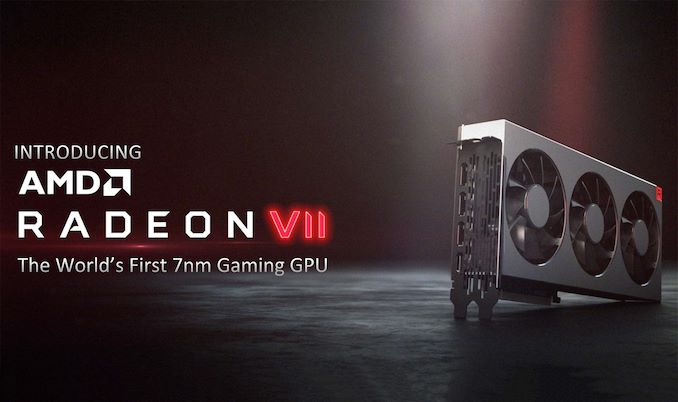
As it turns out, the video card wars are going to charge into 2019 quite a bit hotter than any of us were expecting. Moments ago, as part of AMD’s CES 2019 keynote, CEO Dr. Lisa Su announced that AMD will be releasing a new high-end, high-performance Radeon graphics card. Dubbed the Radeon VII (Seven), AMD has their eyes set on countering NVIDIA’s previously untouchable GeForce RTX 2080. And, if the card lives up to AMD’s expectations, then come February 7th it may just as well do that.
Today’s announcement is interesting in that it’s just as much about technology as it is the 3D chess that is the market positioning fights between AMD and NVIDIA. Technically AMD isn’t announcing any new GPUs here – regular readers will correctly guess that we’re talking about Vega 20 – but the situation in the high-end market has played out such that there’s now a window for AMD to bring their cutting-edge Vega 20 GPU to the consumer market, and this is a window AMD is looking to take full advantage of.
At a high level then, the Radeon VII employs a slightly cut down version of AMD’s Vega 20 GPU. With 60 of 64 CUs enabled, it actually has a few less CUs than AMD’s previous flagship, the Radeon RX Vega 64, but it makes up for the loss with much higher clockspeeds and a much more powerful memory and pixel throughput backend. As a result, AMD says that the Radeon VII should beat their former flagship by anywhere between 20% and 42% depending on the game (with an overall average of 29%), which on paper would be just enough to put the card in spitting distance of NVIDIA’s RTX 2080, and making it a viable and competitive 4K gaming card.
| AMD Radeon Series Specification Comparison | ||||||
| AMD Radeon VII | AMD Radeon RX Vega 64 | AMD Radeon RX 590 | AMD Radeon R9 Fury X | |||
| Stream Processors | 3840 (60 CUs) |
4096 (64 CUs) |
2304 (36 CUs) |
4096 (64 CUs) |
||
| ROPs | 64 |
64 | 32 | 64 | ||
| Base Clock | ? | 1247MHz | 1469MHz | N/A | ||
| Boost Clock | 1800MHz | 1546MHz | 1545MHz | 1050MHz | ||
| Memory Clock | 2.0Gbps HBM2 | 1.89Gbps HBM2 | 8Gbps GDDR5 | 1Gbps HBM | ||
| Memory Bus Width | 4096-bit | 2048-bit | 256-bit | 4096-bit | ||
| VRAM | 16GB | 8GB | 8GB | 4GB | ||
| Single Precision Perf. | 13.8 TFLOPS | 12.7 TFLOPS | 7.1 TFLOPS | 8.6 TFLOPS | ||
| Board Power | 300W? | 295W | 225W | 275W | ||
| Manufacturing Process | TSMC 7nm | GloFo 14nm | GloFo/Samsung 12nm | TSMC 28nm | ||
| GPU | Vega 20 | Vega 10 | Polaris 30 | Fiji | ||
| Architecture | Vega (GCN 5) |
Vega (GCN 5) |
GCN 4 | GCN 3 | ||
| Transistor Count | 13.2B | 12.5B | 5.7B | 8.9B | ||
| Launch Date | 02/07/2019 | 08/14/2017 | 11/15/2018 | 06/24/2015 | ||
| Launch Price | $699 | $499 | $279 | $649 | ||
Diving into the numbers a bit more, if you took AMD’s second-tier Radeon Instinct MI50 and made a consumer version of the card, the Radeon VII is almost exactly what it would look like. It has the same 60 CU configuration paired with 16GB of HBM2 memory. However the Radeon VII’s boost clock is a bit higher – 1800MHz versus 1746MHz – so AMD is getting the most out of those 60 CUs. Still, it’s important to keep in mind that from a pure FP32 throughput standpoint, the Vega 20 GPU was meant to be more of a sidegrade to Vega 10 than a performance upgrade; on paper the new card only has a 9% compute throughput advantage. So it’s not on compute throughput where Radeon VII’s real winning charm lies.
Instead, the biggest difference between the two cards is on the memory backend. Radeon Vega 64 (Vega 10) 2 HBM2 memory channels running at 1.89Gbps each, for a total of 484GB/sec of memory bandwidth. Radeon VII (Vega 20) doubles this and then some to 4 HBM2 memory channels, which also means memory capacity has doubled to 16GB. And then there’s the clockspeed boost on top of this to 2.0Gbps for the HBM2 memory. As a result Radeon VII has a lot memory bandwidth to feed itself, from the ROPs to the stream processors. Given these changes and AMD’s performance estimates, I think this lends a lot of evidence to the idea that Vega 10 was underfed – it needed more memory bandwidth keep its various processing blocks working at full potential – but that’s something we’ll save for the eventual review.
Past that, as this is still a Vega architecture product, it’s the Vega we all know and love. There are no new graphical features here, so even if AMD has opted to shy away from putting Vega in the name of the product, it’s going to be comparable to those parts as far as gaming is concerned. The Vega 20 GPU does bring new compute features – particularly much higher FP64 compute throughput and new low-precision modes well-suited for neural network inferencing – but these features aren’t something consumers are likely to use. Past that, AMD will be employing some mild product segmentation here to avoid having the Radeon VII cannibalize the MI50 – the Radeon VII does not get PCIe 4.0 support, nor does it get Infinity Link support –
The other wildcard for the moment is TDP. The MI50 is rated for 300W, and while AMD’s event did not announce a TDP for the card, I fully expect AMD is running the Radeon VII just as hard here, if not a bit harder. Make no mistake: AMD is still having to go well outside the sweet spot on their voltage/frequency curve to hit these high clockspeeds, so AMD isn’t even trying to win the efficiency race. Radeon VII will be more efficient than Radeon Vega 64 – AMD is saying 25% more perf at the same power – but even if AMD hits RTX 2080’s performance numbers, there’s nothing here to indicate that they’ll be able to meet its efficiency. This is another classic AMD play: go all-in on trying to win on the price/performance front.
Accordingly, the Radeon VII is not a small card. The photos released show that it’s a sizable open-air triple fan cooled design, with a shroud that sticks up past the top of the I/O bracket. Coupled with the dual 8-pin PCIe power plugs on the rear of the card, and it’s clear AMD intends to remove a lot of heat. Both AMD and NVIDIA have now gone with open-air designs for their high-end cards on this most recent generation, so it’s an interesting development, and one that favors AMD given their typically higher TDPs.
Vendor performance claims should always be taken with a grain of salt, but for the moment this is what we have. If AMD manages to reach RTX 2080 performance, then I expect this to be another case of where the two cards are tied on average but are anything but equal; there will be games where AMD falls behind, games where they do tie the RTX 2080, and then even some games they pull ahead in. These scenarios are always the most interesting for reviewers, but they’re also a bit trickier for consumers since it means there’s no clear-cut winner.
All told then, the competitive landscape is going to be an interesting one. AMD’s own proposition is actually fairly modest; with a $699 price tag they’re launching at the same price as the RTX 2080, over four months after the RTX 2080. They are presumably not going to be able to match NVIDIA’s energy efficiency, and they won’t have feature parity since AMD doesn’t (yet) have its own DirectX Raytracing (DXR) implementation.
But what AMD does have, besides an at least competitive price and presumably competitive performance in today’s games, is a VRAM advantage. Whereas NVIDIA didn’t increase their VRAM amounts between generations, AMD is for this half-generation card, giving them 16GB of VRAM to RTX 2080’s 8GB. Now whether this actually translates into a performance advantage now or in the near future is another matter; AMD has tried this gambit before with the Radeon 390 series, where it didn’t really pay off. On the other hand, the fact that NVIDIA’s VRAM capacities have been stagnant for a generation means that AMD is delivering a capacity increase “on schedule” as opposed to ahead of schedule. So while far from guaranteed, it could work in AMD’s favor. Especially as, given the performance of the card, AMD intends for the Radeon VII to be all-in on 4K gaming, which will push memory consumption higher.
Finally on the gaming front, not content to compete on just performance and pricing, AMD will also be competing on gaming bundles. The Radeon VII will be launching with a 3 game bundle, featuring Resident Evil 2, Devil May Cry 5, and The Division 2. NVIDIA of course launched their own Anthem + Battlefield V bundle at the start of this week, so both sides are now employing their complete bags of tricks to attract buyers and to prop up the prices of their cards.
Speaking of pricing, perhaps the thing that surprises me the most is that we’re even at this point – with AMD releasing a Vega 20 consumer card. When they first announced Vega 20 back in 2018, they made it very clear it was going to be for the Radeon Instinct series only. That the new features of the Vega 20 GPU were better suited for that market, and more importantly as a relatively large chip (331mm2) for this early in the life of TSMC’s 7nm manufacturing node, yields were going to be poor.
So that AMD is able to sell what are admittedly defective/recovered Vega 20s in a $699 card, produce enough of them to meet market demand, and still turn a profit on all of this is a surprising outcome. I simply would not have expected AMD to get a 7nm chip out at consumer prices this soon. All I can say is that either AMD has pulled off a very interesting incident of consumer misdirection, or the competitive landscape has evolved slowly enough that Vega 20 is viable where it otherwise wouldn’t have been. Or perhaps it’s a case of both.
Shifting gears for a second, while I’ve focused on gaming thus far, it should be noted that AMD is going after the content creation market with the Radeon VII as well. This is still a Radeon card and not a Radeon Pro card, but as we’ve seen before, AMD has been able to make a successful market out of offering such cards with only a basic level of software developer support. In this case AMD is expecting performance gains similar to the gaming side, with performance improving the more a workload is pixel or memory bandwidth bound.
Wrapping things up, the Radeon VII will be hitting the streets on February 7th for $699. At this point AMD has not announced anything about board partners doing custom designs, so it looks like this is going to be a pure reference card launch. As always, stay tuned and we should know a bit more information as we get closer to the video card’s launch date.


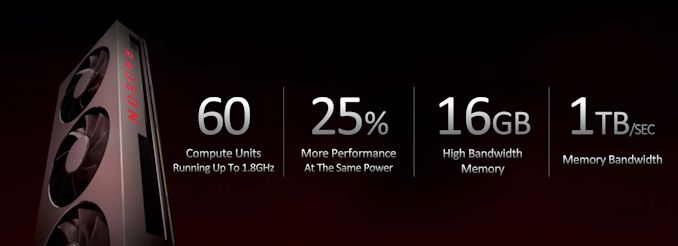

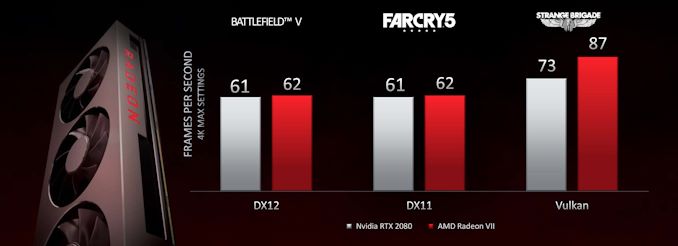
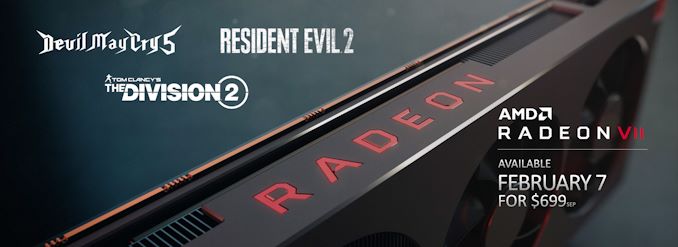
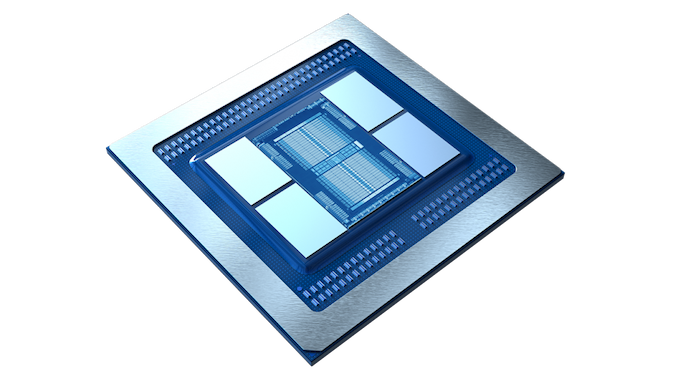








201 Comments
View All Comments
KOneJ - Friday, January 11, 2019 - link
I think they had some MI50/60 dies that they couldn't use and figured they throw this out there.KOneJ - Friday, January 11, 2019 - link
Was kind of wondering about this when Instinct cards launched. forgot about it until I saw the VII trademark logo.sing_electric - Wednesday, January 9, 2019 - link
I don't think any of us were expecting to see AMD come out swinging at the RTX 2080 in 2019, let alone in the first half of 2019, so that's a plus and bodes well for people wanting a high-end GPU at something close to the MSRP. It's interesting that the branding doesn't readily allow for variations (like 590/580/570, or 64/56), making me think that AMD may have rushed this to market as a stop-gap product (possibly due to a combination of yields being better on the chips for Radeon Instinct than expected and how most of us thought that this was going to be another lost year for Radeon).Having said that, I'm surprised that AMD's doubling down on HBM2 - I wonder if prices have come down more than I've heard, since I've thought that the high cost of that memory (both in terms of chips, but also the expensive interposer and board design that the tech requires) has limited AMD's ability to lower the cost of Vega boards to the point where they're $/perf competitive with Nvidia.
In either case, it puts AMD in the unique situation of offering 3 generations of products (Vega 20, Vega 10 and Polaris) at 4 different processes (7nm Radeon VII, 14nm Vega and Polaris, and 12nm Polaris) to target different parts of the dGPU market.
Meaker10 - Wednesday, January 9, 2019 - link
My guess is yields have done a fair bit better than expected and this is helping eat the price penalty of HBM along with GDDR6 being closer in price.sing_electric - Wednesday, January 9, 2019 - link
I hadn't thought about how much more expensive GDDR6 is compared to 5. When AMD didn't release any HBM-based cards in the 400/500 series, I'd thought the tech might be going the way of RAMBUS; we'll see how the Radeon VII performs but it now seems like it may actually offer an interesting way of increasing performance.KateH - Wednesday, January 9, 2019 - link
i agree that this is not what was expected. rumors were pointing to a Navi-based GTX1080/RTX2060 competitor at similar price point to 2060, not a GTX1080Ti/RTX2080 competitor at the same price point as the 2080. Which leaves the question, what is AMD going to do in the midrange space? Right now they have nothing to go against the 2060. AMD painted themselves into a corner in the midrange with the RX590- too hot, too expensive, too slow. At $149-$199 and tweaked to bring the power down to =<175W Polaris might still make sense in 2019 but as-is they have nothing unless they rebrand Vega56 and drop it to $249-$299, which isn't going to happen.sing_electric - Wednesday, January 9, 2019 - link
Totally agree- they're in a weird space at the moment. The "Radeon VII" branding with no other suffix makes me think that this is the only chip that AMD will release on VIInm for a while, so other releases are likely to be on the 14/12nm.The 590 move is really confusing to me - why bother porting a design from 2015 (since the 580 is just a 480 that's factory overclocked) to a slightly smaller process, particularly when you don't gain much in headroom (since if Intel was naming things, GloFo's 12nm is more like a '14nm++'). The 580 was the best deal below $200 until the 2060 dropped pushing 1060 6B prices down (though it's still not a *bad* deal). Maybe an OEM was willing to do a bulk purchase or something.
There's two moves I can see: One, a Radeon VII with less memory - following Nvidia's lead with say, the 1060 3/6GB; the other, they do for Vega what they did with the 590, shrink it to 12nm (and possibly pair it with GDDR, though it looks like Vega performance is VERY bandwidth dependent), or possibly pair it with less HBM2. They could release it under the Vega name and use a number that indicated performance instead of ROPs (so like, a 56 ROP clocked faster after the shrink might be the Vega 60 or something).
Still, any way you cut it, it's way more confusing than Nvidia, which is pushing Turing and letting Pascal stocks dry up.
mode_13h - Wednesday, January 9, 2019 - link
You have to consider when the RX 590 would've originated. That would be back when cryptomining was still hot.Given what they've said about their 12 nm Ryzen die, it sounds like the process transition to 12 nm was very low effort. So, my guess is that it was seen as low-hanging fruit that made them more competitive vs. GTX 1060 (6 GB). Perhaps they were (typically) optimistic about the power savings or clock headroom of the 12 nm process. If it were a bit more efficient, then I think it would look much more compelling.
Karmena - Thursday, January 10, 2019 - link
what is NVIDIA doing in midrange space? Looking at prices 2060 is not midrange. 2060 is not 1080 performance. it is more 1070Ti. And people are saying that 2070 already has issues with ray tracing performance to be useful. So 2060 completely negates RTX part of the name anyway.sing_electric - Thursday, January 10, 2019 - link
AMD is in a really weird place now, having just re-released shrunk versions of its architectures from 2015 (RX 590, a 12nm shrink since its still Polaris from the RX 480 (which was overclocked to become the 580)) and 2017 (Vega 7nm), but not really a new unified architecture to target high/mid (low?).My bet is that Radeon VII (and the 590) are stopgap products until Navi is ready. I think most of us were surprised about the VII, which may mean that Radeon Instinct MI yields were better than expected, or demand was lower than expected, or just that AMD realized they could make money on them at $700.